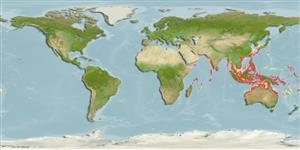Common names from other countries
Environment: milieu / climate zone / depth range / distribution range
Ekologi
; kisaran kedalaman 0 - 40 m (Ref. 349). Tropical
Indo-West Pacific: from Madagascar and the Persian Gulf, to eastern Melanesia; north to Japan and south to Queensland and New Caledonia.
Length at first maturity / Size / Weight / umur
Maturity: Lm ? range ? - ? cm Max length : 4.5 cm SHL jantan/; (Ref. 349); common length : 3.0 cm SHL jantan/; (Ref. 349)
Used as food and for its shell (Ref. 349). From shallow subtidal levels. Members of the family Naticidae are sand or mud-dwelling, ploughing through the substrate with their expanded foot. They are active predators, preying mainly on burrowing bivalves or gastropods (Ref. 349).
Life cycle and mating behavior
Kematangan | Reproduksi, perkembang biakan | Pemijahan | telur-telur | Fecundity | Larva
Members of the order Neotaenioglossa are mostly gonochoric and broadcast spawners. Life cycle: Embryos develop into planktonic trocophore larvae and later into juvenile veligers before becoming fully grown adults.
rujukan utama
Acuan | Koordinator | mitra
Poutiers, J.M. 1998. (Ref. 349)
Status IUCN Red List (Ref. 130435)
status CITES (Ref. 108899)
Not Evaluated
Not Evaluated
ancaman kepada manusia
Harmless
penggunaan manusia
| FishSource |
Alat, peralatan
informasi lanjut
Umur / SaizPertumbuhanpanjang-beratpanjang-panjangMorfologiLarvaKelimpahan
Sumber internet
Estimates based on models
Preferred temperature
(Ref.
115969): 24.6 - 29.1, mean 28.2 (based on 1044 cells).
keancaman
Low vulnerability (10 of 100).
kategori harga
Unknown.
